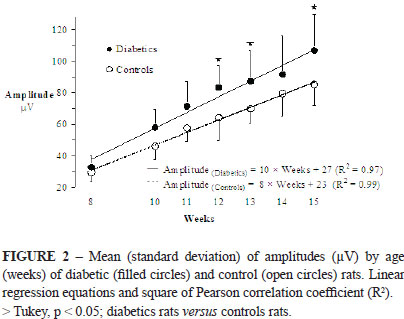PURPOSE: To investigate sensory nerve conduction of the caudal nerve in normal and diabetic rats. METHODS: Diabetes was induced in twenty 8-weeks old Wistar male rats. Twenty normal rats served as controls. Caudal nerve conduction studies were made before diabetes induction and the end of each week for six consecutive weeks. The caudal nerve was stimulated distally and nerve potentials were recorded proximally on the animal's tail using common "alligator" clips as surface electrodes. RESULTS: After induction, nerve conduction velocities (NCV) increased slower in the diabetic than in the control group. Sensory nerve action potentials (SNAP) conduction velocities increased slower in the diabetic than in the control group (slope of regression line: 0.5 vs 1.3m/s per week; NCV in the 15th week = 39±3m/s vs 44±4m/s). Tukey's tests showed differences between groups at the 11th, 13th and 15th weeks old. From the 10th week on, SNAP amplitudes increased faster in the diabetic than in the control group (slopes of the regression line: 10 vs 8µV per week; SNAP amplitudes in the 15th week: 107±23µV vs 85±13µV). Differences at the 12th, 13th and 15th weeks were significant. CONCLUSION: In diabetic rats nerve conduction velocities were slower whereas amplitudes were larger than in normal rats.
Diabetes Mellitus, Experimental; Neural Conduction; Tail; Rats




